Nerium
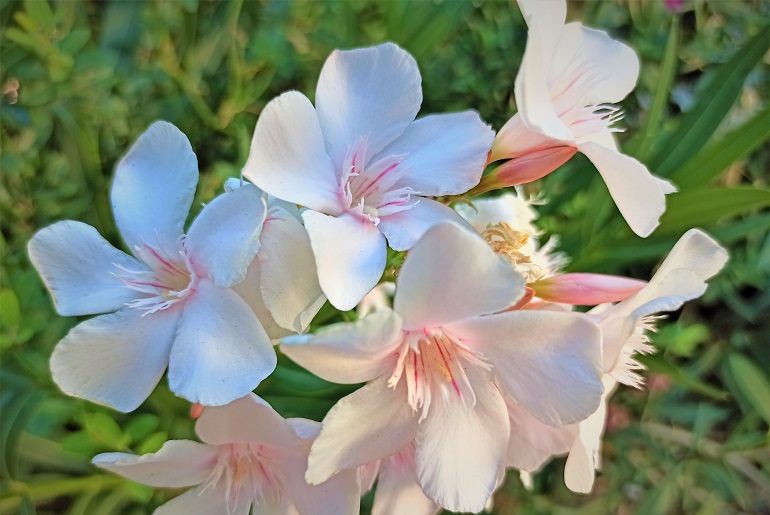
This post is also available in:
This post is also available in:
![]() Español (Spanish)
Español (Spanish) ![]() Français (French)
Français (French) ![]() Deutsch (German)
Deutsch (German) ![]() Nederlands (Dutch)
Nederlands (Dutch) ![]() हिन्दी (Hindi)
हिन्दी (Hindi) ![]() العربية (Arabic)
العربية (Arabic) ![]() 简体中文 (Chinese (Simplified))
简体中文 (Chinese (Simplified)) ![]() Italiano (Italian)
Italiano (Italian) ![]() 한국어 (Korean)
한국어 (Korean)
In separating road-islands of highways, in the side of the streets, in yards or balconies, and in the “heart” of a city, nerium, also known as oleander, can thrive and impress the passengers with its numerous and colorful flowers.
This native to the Mediterranean region shrub is one of the most versatile plants that can grow with minimal care after a certain point in their lives. Nerium has a pretty high growth rate that can reach several meters in height, creating nice, dense natural fences.
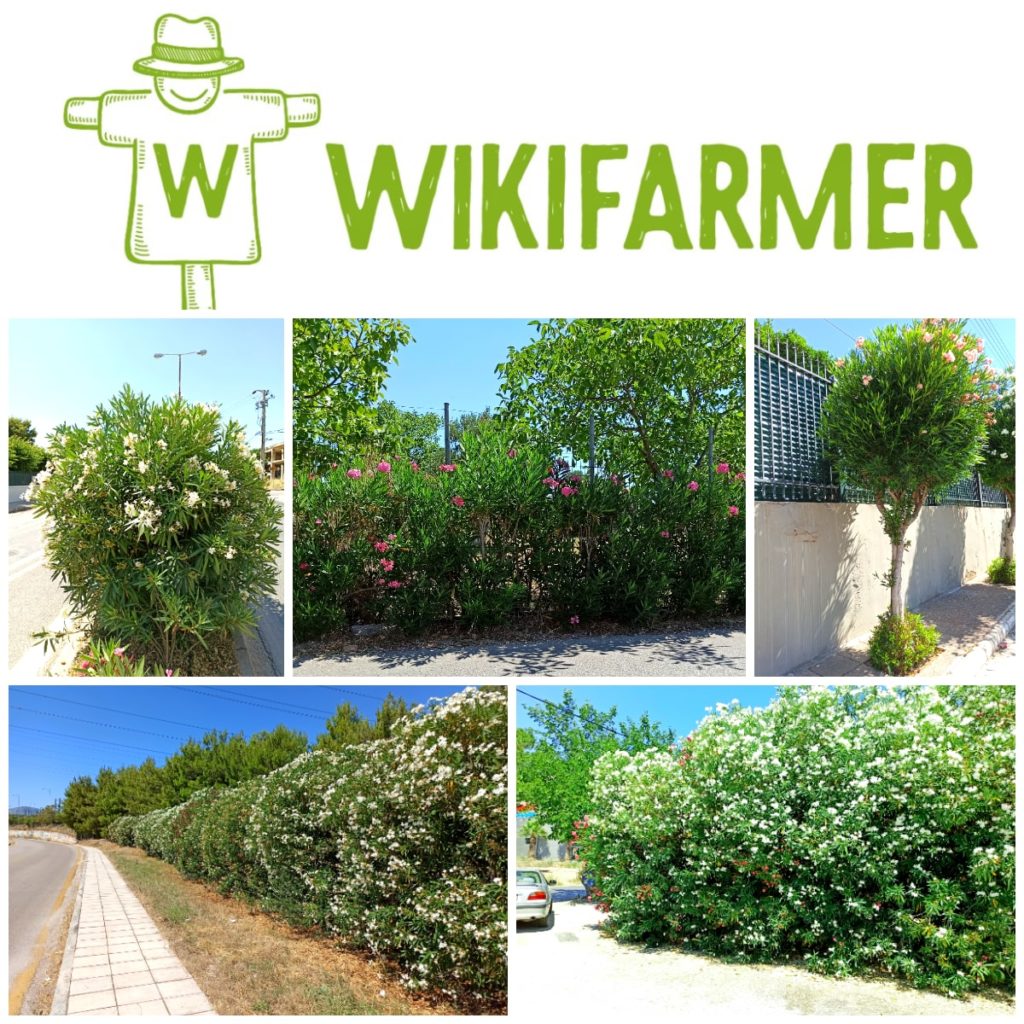 The scientific name of this widespread plant is Nerium oleander. It is a perennial, evergreen, ornamental shrub that can even exceed 5 meters in height, as we see in the photos. It has flowers of different colors, with the most common colors being pink, white, red, and cream. We should not confuse it with laurel (Laurus nobilis), which we use in cooking. Nerium has toxic leaves, which are poisonous to humans and pets. Contact with nerium foliage and flowers may cause severe skin irritation and allergic reactions. For this reason, we always wear suitable protective gloves when we take care of this plant.
The scientific name of this widespread plant is Nerium oleander. It is a perennial, evergreen, ornamental shrub that can even exceed 5 meters in height, as we see in the photos. It has flowers of different colors, with the most common colors being pink, white, red, and cream. We should not confuse it with laurel (Laurus nobilis), which we use in cooking. Nerium has toxic leaves, which are poisonous to humans and pets. Contact with nerium foliage and flowers may cause severe skin irritation and allergic reactions. For this reason, we always wear suitable protective gloves when we take care of this plant.
As with many ornamental shrubs, there are dwarf and full-grown nerium varieties. Most dwarf varieties reach a height of 1.20 to 1.40 meters (4.6 feet) after 2-3 years, and then they stop growing further. On the other hand, common (full-sized) neriums have a high-speed growth rate. If such a plant finds favorable conditions, it can gain 50 to 70 cm or more height per year. Gardeners, usually prefer to use these plants to create large plant fences in a short period of time. For example, if we plant a row of plants 1.5 meters (5 feet) high, within 1-2 years, we will get a hedge 2.50 to 3 meters (9.8 feet) tall, providing the isolation we desire.
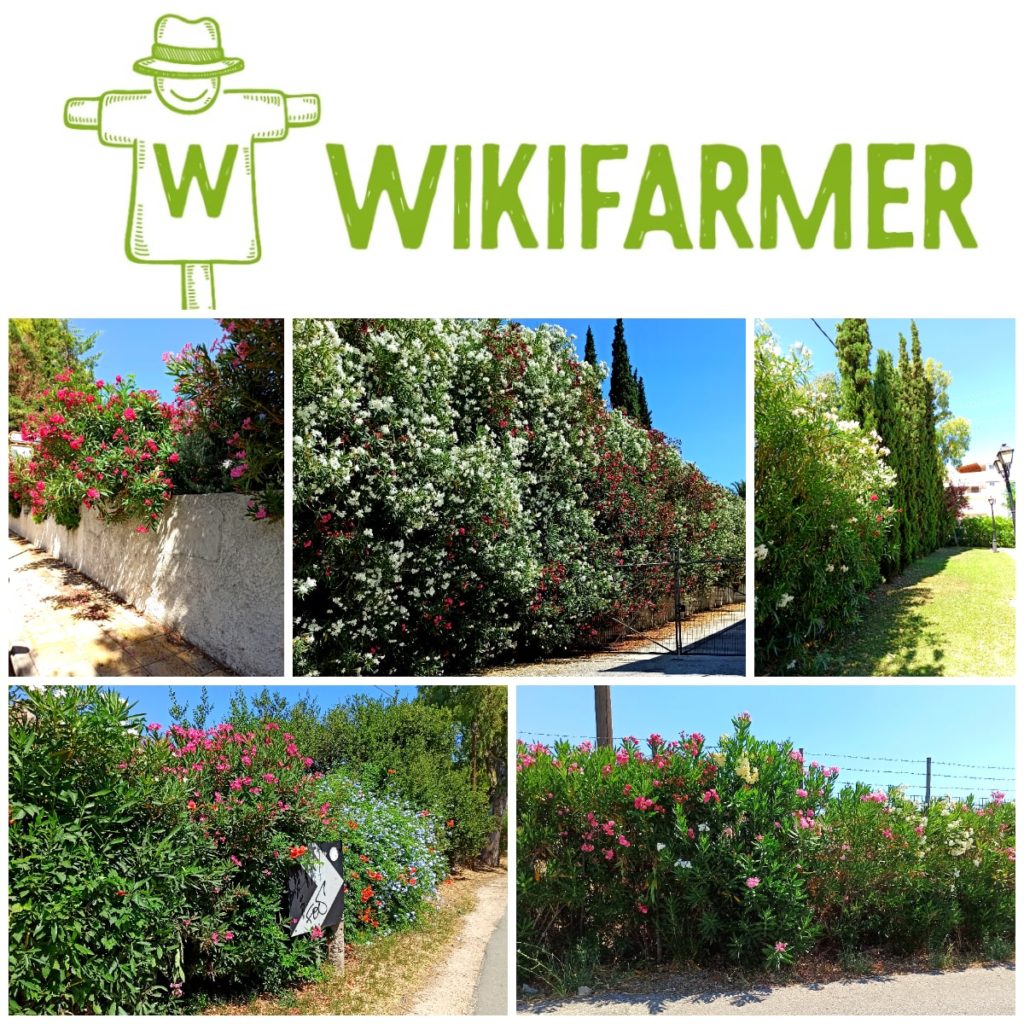 Despite its generally resistant nature, nerium needs sunshine and direct access to sunlight for at least 6 hours a day. Under shade- as we see in the photo- it becomes cachectic with thin and weak shoots, producing less vegetation and flowers. Thanks to the high drought tolerance of the plant, the water demand is very low. For this reason, most of the plants older than three years encountered on roads’ sides are not irrigated.
Despite its generally resistant nature, nerium needs sunshine and direct access to sunlight for at least 6 hours a day. Under shade- as we see in the photo- it becomes cachectic with thin and weak shoots, producing less vegetation and flowers. Thanks to the high drought tolerance of the plant, the water demand is very low. For this reason, most of the plants older than three years encountered on roads’ sides are not irrigated.
However, to ensure that the plant will survive and grow properly, the first and maybe the second summer after planting in the ground we need to water regularly. As for the soil, nerium does not have any special requirements, as it can thrive in barren soils and a wide range of pH and salinity. Reports mention that it can grow even at pH slightly above 8, while its resistance to salinity makes it ideal for planting in coastal areas.
Planting nerium to the soil
Spring and autumn are the best seasons for transplanting nerium. After buying our plants, the first thing to do is to remove all dried plant material with pruning shears. This way, we will help them concentrate their resources and valuable nutrients into fewer but more impressive flowers. So first, we remove the withering flowers. It is good to cut all the shoots that hold the withering flowers up to the previous node. This will allow young buds to form and grow better, rewarding us very soon with their appearance, vitality, and colors. The pruning shears we will use during the deadheading must be of high quality and accompanied by the corresponding certificates.
Later on, we dig a hole larger in diameter than that of the pot and plant our shrub. If we want to create a hedge, the distance between two nerium plants must be at least one and a half meters (5 feet).
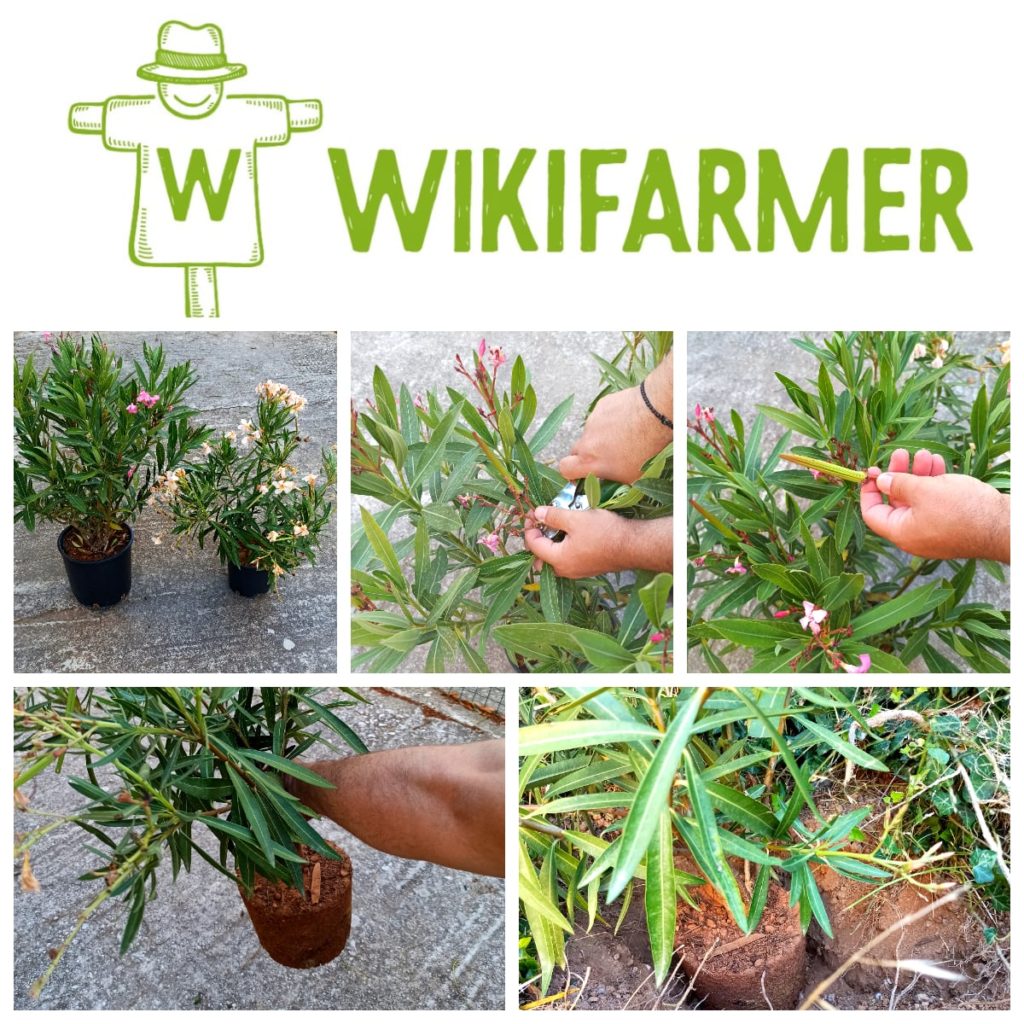 Pruning nerium plants
Pruning nerium plants
Although it is not absolutely necessary, pruning can serve as a means to promote blooming and increase the hedge’s density. Pruning is essential, especial in plants with a great growth rate like nerium. We need to have a clear pruning plan in our mindwellie beforehand and decide what shape and size we want our plant to have. We can shape it as a tree or into a dense small bush (by pruning it strictly every two years), encourage a vertical growth to create tall hedges, or do nothing of the above.
While we can remove any dry shoots or frost-damaged plant parts during spring, we perform the main pruning in autumn. The plant flowers on old (last year’s) wood, so it is best not to prune the hole plant at once, as this will lead to a year without blooming. The idea is to prune ⅓ (one third) of the total number of branches every year so that the hole bush will be pruned within three years. Pruning should be done in early autumn and not later to avoid any frost damage. As a general rule, if we prune old wood, new and long shoots will appear. If we cut part of blooming stems, we will get smaller shoots that will flower quickly.
If we want to shape a nerium as a tree, we start by choosing the most vigorous shoot, which will serve as the trunk. After we determine the desired trunk height, we prune any branch of the central trunk above that height. We must repeat the above steps for a long time and remove any suckers to maintain the tree-like structure we want to succeed.
We must keep in mind that all plant parts are toxic, especially the milky sap secreted from cuts or wounds. To stay safe and avoid skin irritations during gardening, we need to wear suitable gloves of good quality and a long-sleeved blouse. Furthermore, after pruning, we should wash our tools and hands. Cleaning our equipment ensures that the next time we use it, we will not run any risk.
Personal safety is an essential factor in pruning. Gardening may be a seemingly harmless hobby, but it has risks that a beginner may not have imagined. Besides protected gloves, we need to invest in buying good quality wellies (rain-boots). The garden often, especially in late summer and early autumn, when nerium is usually pruned, attracts some unwanted visitors looking for food, such as snakes or mice. As a result, to stay protected and walk around safely and comfortably, we need to buy wellies (rubber boots) of good quality.
Fertilization of nerium
Mature plants have little or no need for fertilization. However, adding fertilizer to a young nerium plant will help it maximize its growth rate and reach the desired height and density sooner, especially in case we want them to serve as a hedge. We can fertilize our plants three times a year: in early spring, when new vegetation first appears, then in late spring, and once again during summer. Any balanced fertilizer (e.g., N-P-K 10-10-10) that is also suitable for the vegetables of our garden will do the trick-job.
Growing nerium in a flowerpot
Many choose to plant nerium in a pot on the balcony. In this case, a dwarf nerium variety that will not exceed 1.5 meters (5 feet) in height is more appropriate. Petite Pink (pink flowers) and White Sands (white flowers) are the two most popular varieties for that use.
We need to take care of six things for having our nerium plants in pots blooming for many years.
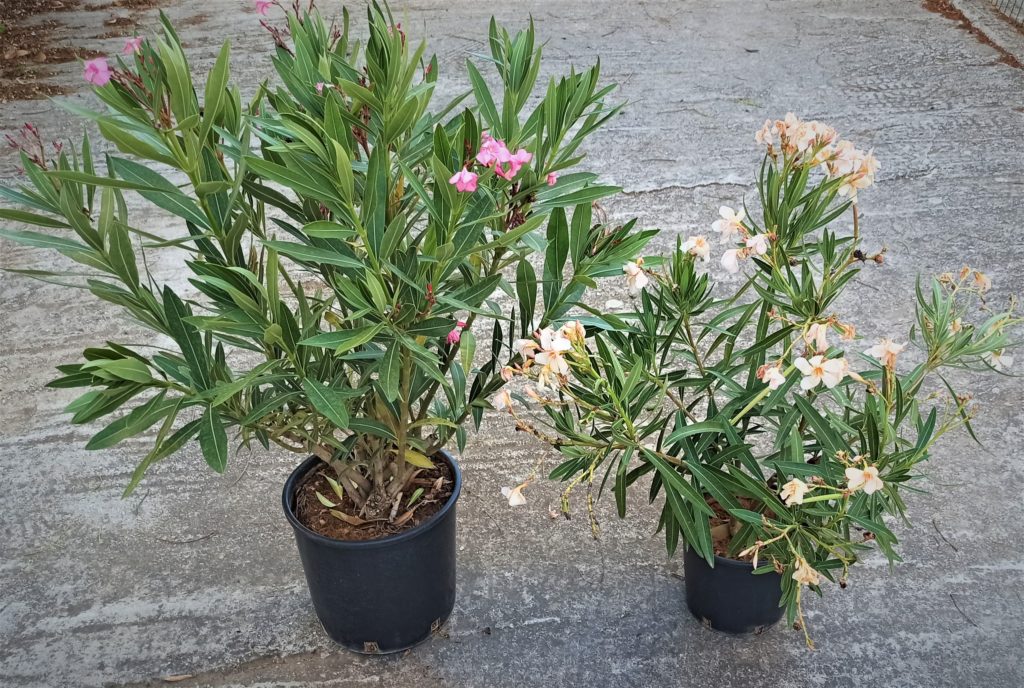 6 secrets for growing nerium in a pot:
6 secrets for growing nerium in a pot:
- We must place our pot in a spot with direct access to sunlight for at least 6 hours a day. At the same time, the plants should not be easily reached by children or pets. We must never forget that despite its external beauty, the plant is toxic. Simple contact with it can cause skin irritation and allergic reactions while swallowing a leaf can be very dangerous.
- Contrary to nerium plants growing in soil, potted plants are less drought-tolerant. Especially in summer, we should water it regularly, after finding with our fingers that the pot’s soil is completely dry.
- In the first one to two years of plant life, it is suggested to add a balanced fertilizer twice a year (once in spring and once in summer). We can choose between a simple blue granular fertilizer and a water-soluble fertilizer. In the first case, we need to water after the application of the fertilizer.
- After flowering and before we move the pot to a protected place for the winter, we can prune the plants. Usually, we cut to half their length one-third of the branches to maintain a nice compact shape. We repeat the process for two more years to complete the pruning of the hole bush.
- We need always to wear protected gloves when pruning our nerium plants.
- Towards the end of autumn, we may need to change the position of the pot with our nerium, to protect it from the cold and frost. Temperatures lower than -10°C (14 degrees Fahrenheit) can stress the plants, causing significant damage, especially when the frost lasts several hours. In such conditions, we can protect our plants by changing the position of our pots (even putting them in interior spaces) or by covering them.








































































